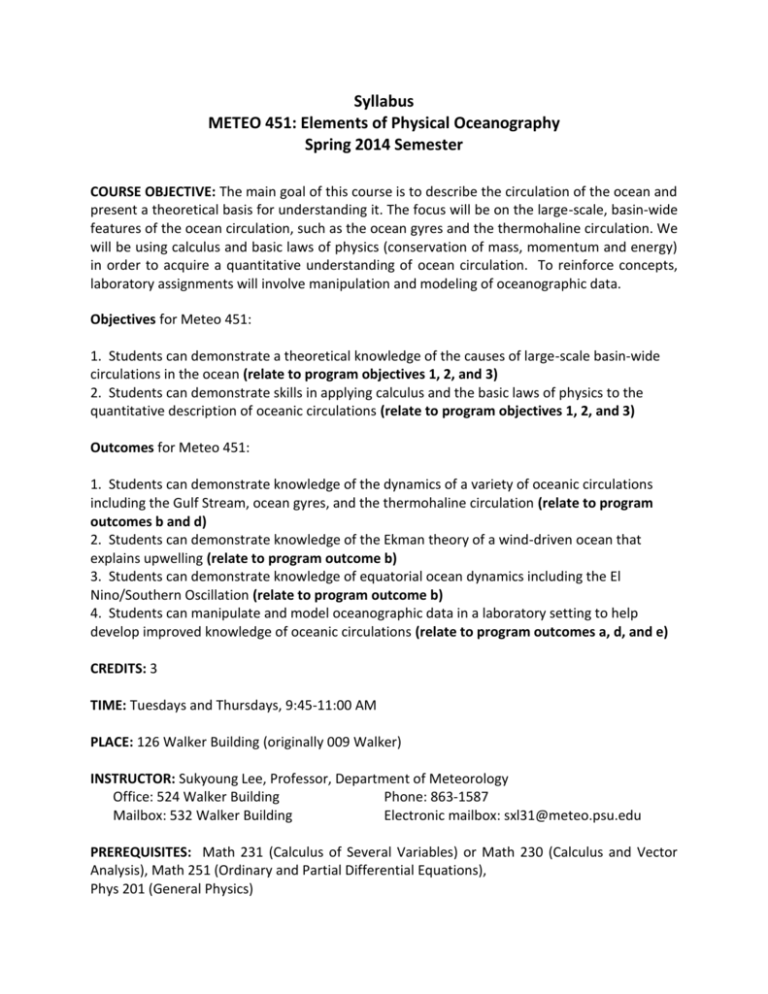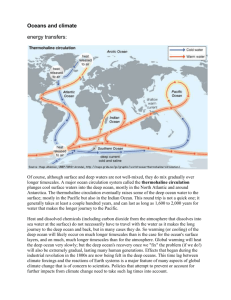METEO 451_Lee_SP2014 - Department of Meteorology
advertisement

Syllabus METEO 451: Elements of Physical Oceanography Spring 2014 Semester COURSE OBJECTIVE: The main goal of this course is to describe the circulation of the ocean and present a theoretical basis for understanding it. The focus will be on the large-scale, basin-wide features of the ocean circulation, such as the ocean gyres and the thermohaline circulation. We will be using calculus and basic laws of physics (conservation of mass, momentum and energy) in order to acquire a quantitative understanding of ocean circulation. To reinforce concepts, laboratory assignments will involve manipulation and modeling of oceanographic data. Objectives for Meteo 451: 1. Students can demonstrate a theoretical knowledge of the causes of large-scale basin-wide circulations in the ocean (relate to program objectives 1, 2, and 3) 2. Students can demonstrate skills in applying calculus and the basic laws of physics to the quantitative description of oceanic circulations (relate to program objectives 1, 2, and 3) Outcomes for Meteo 451: 1. Students can demonstrate knowledge of the dynamics of a variety of oceanic circulations including the Gulf Stream, ocean gyres, and the thermohaline circulation (relate to program outcomes b and d) 2. Students can demonstrate knowledge of the Ekman theory of a wind-driven ocean that explains upwelling (relate to program outcome b) 3. Students can demonstrate knowledge of equatorial ocean dynamics including the El Nino/Southern Oscillation (relate to program outcome b) 4. Students can manipulate and model oceanographic data in a laboratory setting to help develop improved knowledge of oceanic circulations (relate to program outcomes a, d, and e) CREDITS: 3 TIME: Tuesdays and Thursdays, 9:45-11:00 AM PLACE: 126 Walker Building (originally 009 Walker) INSTRUCTOR: Sukyoung Lee, Professor, Department of Meteorology Office: 524 Walker Building Phone: 863-1587 Mailbox: 532 Walker Building Electronic mailbox: sxl31@meteo.psu.edu PREREQUISITES: Math 231 (Calculus of Several Variables) or Math 230 (Calculus and Vector Analysis), Math 251 (Ordinary and Partial Differential Equations), Phys 201 (General Physics) CLASS STRUCTURE: During a typical week I will lecture on Tuesdays and the first 25 minutes on Thursdays. For the rest of the Thursday period, you will work on a laboratory exercises. REQUIRED READING MATERIAL: The course materials are posted on ANGEL, Penn State’s Course Management System. ANGEL can be accessed at cms.psu.edu using your PSU username and password. You will be able to download notes chapter by chapter in Adobe PDF format. The guidelines for laboratory reports are also posted on ANGEL in guideline_lab_report.pdf KEY REFERENCES: Stewart, R. H., 2008: Introduction to Physical Oceanography. (freely available on web) http://oceanworld.tamu.edu/home/course_book.htm Marshall, J., and R. A. Plumb, 2008: Atmosphere, Ocean, and Climate Dynamics: An Intoductory Text, Academic Press, 344 pp. (Course reserve for this book has been requested to the EMS library.) LAB EXERCISES: There are four lab exercises, and these will be assigned every 3 weeks or so. For each lab, the lab instructions, Matlab codes, and some data files are posted on ANGEL. They will typically require several additional hours of work outside of the lab period. The assignments will engage you directly in oceanographic data analysis and modeling, using the programming language Matlab, which is easy to learn. Matlab is also quite useful in science and engineering and thus many of your prospective employers (including graduate school research advisers) will be pleased that you know it. I anticipate that most of your learning will occur as you do these assignments. TESTS: There will be one mid-term exam and a final exam. The tentative date for the mid-term exam is Tuesday, March 4. The final exam will occur during finals week; the schedule has not yet been released. GRADES: Undergraduates A: 92-100%; A-: 88-91%; B+: 84-87%; B: 80-83%; B-: 75-79%; C+: 71-74%; C: 63-70%; D: 50-62%; F: < 50% Graduate Students A: 94-100%; A-: 90-93%; B+: 87-89%; B: 84-86%; B-: 80-83%; C+: 77-79%; C: 70-76%; D: 60-69%; F: < 60% Weighting: 50% homework (i.e., the lab reports), 20% mid term, 30% final. CLASS PARTICIPATION: The learning environment is enhanced when students are actively engaged. I therefore encourage you to ask questions and present your point of view in class. In addition, the class participation will help me to write an informative reference letter if you ever want me to write one on your behalf. Office-hour contacts can also accomplish this goal. ACADEMIC INTEGRITY POLICY: I expect all submitted work to be your own. Tests will be closed book and no crib sheets are allowed. Feel free to discuss lab assignments with others, but never copy another’s work or use a program another student has written without my consent. For details see http://www.ems.psu.edu/current_undergrad_students/academics/integrity_policy ATTENDANCE POLICY: I expect you to attend all classes. I realize that there may be emergencies and other extenuating circumstances that prevent this. If possible, let me know ahead of time if you are going to miss a class. OFFICE HOURS: Tues. & Thurs.: 11:00 PM - Noon. I will be in my office during these hours specifically to answer your questions. Exceptions will occur due to unavoidable meetings, illness and travel. I am often available outside of office hours, so please feel free to stop by my office at any time. If I’m available, I’ll be happy to talk with you. TOPICS: 1. Introduction 2. The equation of state for seawater (lab1) 3. Static stability in the ocean 4. The conservation equations 5. Geostrophic and inertial flow (lab 2 & 3) 6. Ekman flow 7. Sverdrup flow and westward intensification (Lab 4) 8. Air-sea heat and fresh water fluxes 9. The surface ocean mixed layer Lab report deadlines: February 6 February 27 March 27 April 24 Lab #1 due Lab #2 due Lab #3 due Lab #4 due 10. The thermohaline circulation 11. Tropical oceanography 12. El Niño 13. The Southern Ocean






